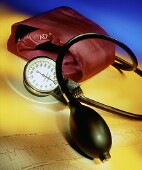- Navigating Your Midlife Crisis: Embracing New Possibilities
- City Raccoons Showing Signs of Domestication
- Mapping the Exposome: Science Broadens Focus to Environmental Disease Triggers
- One Week Less on Social Media Linked to Better Mental Health
- Your Brain Changes in Stages as You Age, Study Finds
- Some Suicide Victims Show No Typical Warning Signs, Study Finds
- ByHeart Formula Faces Lawsuits After Babies Sickened With Botulism
- Switch to Vegan Diet Could Cut Your Greenhouse Gas Emissions in Half
- Regular Bedtime Does Wonders for Blood Pressure
- Dining Alone Could Mean Worse Nutrition for Seniors
Home Blood Pressure Monitors May Occasionally Miss the Mark


A small new study raises more questions about the accuracy of home blood-pressure monitoring devices.
On average, researchers found, the readings were slightly inaccurate in up to 15 percent of patients. The readings were off by more than 10 mm Hg — a potentially significant difference in a blood pressure reading — in about 8 percent of cases.
There’s no way to know whether the inaccuracies are likely to mislead patients into seeking care when they don’t need it or not getting care when it’s required. It’s also not known if physicians would be able to detect that something is wrong with the readings because they’re different from those derived from more accurate machines at the doctor’s office.
Still, the findings add to previous research suggesting that the in-home devices aren’t perfect.
“Home blood pressure machines should be tested against a reliable device,” like one in a doctor’s office, said study co-author Dr. Swapnil Hiremath, a kidney specialist at The Ottawa Hospital and University of Ottawa in Canada. “I recommend my patients get one whenever possible, but now I get them checked out.”
Home blood-pressure monitors are widely available at drug stores and online. They’re often sold for as little as $25 or $30, said Dr. Willie Lawrence, chief of cardiology at Research Medical Center in Kansas City, Mo., and patients use them to track their blood pressure over time at home. This helps doctors monitor whether patients are suffering from high blood pressure or properly controlling it.
The monitors are common and “very valuable,” said Lawrence, who pointed to research that’s shown home monitoring is beneficial and lowers rates of high blood pressure.
In the new study, Hiremath and colleagues looked at data from 210 patients — 60 percent men, with an average age of 67 — who brought their blood-pressure monitors to the doctor’s office.
“Our nurse, an RN, would measure blood pressure in both arms using the office blood pressure machine,” he said. “Once it was confirmed that there was no difference between arms, measurements were taken in both arms simultaneously — one with the home machine, one with the office machine. Since the data we report is from measurements taken by the RN, this is not a case of patient error.”
The office machine was considered to be accurate.
On average, the systolic and diastolic blood pressure readings — the upper and lower numbers, respectively — were only a few points off in the home devices. Between 30 percent and 32 percent of the time, the blood pressure readings were off by 5mm Hg with the home devices. But the readings were off by more than 10mm Hg — a difference that could be significant — between 8 percent and 9 percent of the time.
“It is hard to say what the source of this error is,” Hiremath said. “Since not all the machines were brand-new, some of the inaccuracies may be from wear and tear.”
How much might the differences matter? It’s hard to say, Hiremath said. In some cases, an inaccurate reading might not result in a different treatment compared to an accurate reading. A reading of, say, “155 vs. 166 will still often result in the same decision,” he said. But it’s also possible that a small difference could mislead a physician and result in a different kind of decision, he added.
Lawrence said the findings shouldn’t be seen as a reason to stop using the devices. Instead, he said, patients can take them to their doctor’s offices to check their accuracy. While it’s not clear what qualifies as the “gold standard” for blood pressure monitors at a doctor’s office, he said electronic monitors are more reliable than the old-fashioned approach of manually using a cuff, stethoscope and pump.
The study is to be presented at the American Society of Nephrology meeting, to be held from Nov. 11 to Nov. 16 in Philadelphia. Findings released at conferences should be considered preliminary because they haven’t gone through the peer-review process required of research published in major medical journals.
More information
For more about monitoring blood pressure at home, try the American Heart Association.
Source: HealthDay
Copyright © 2025 HealthDay. All rights reserved.










